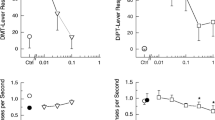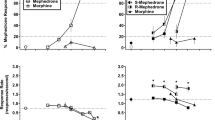Abstract
Investigations conducted over the past 3 decades have demonstrated that serotonergic receptors, specifically the 5-HT2A and 5-HT2C subtypes, play an important role in the behavioral effects of hallucinogenic compounds. The present study was designed to determine the respective significance of these two receptors in the stimulus effects of LSD and (−)DOM in the rat. Specifically, the interactions of a series of serotonergic antagonists (risperidone, pirenpirone, metergoline, ketanserin, loxapine, LY53857, pizotyline, spiperone, cyproheptadine, mesulergine, promethazine, and thioridazine) with the LSD stimulus and the (−)DOM stimulus in LSD-trained subjects was defined. From these data, IC50 values were determined for the inhibition of the LSD-appropriate responding elicited by either 0.1 mg/kg LSD (15-min pretreatment time) or 0.4 mg/kg (−)DOM (75-min pretreatment). In addition, the affinities of these antagonists for 5-HT2A and 5-HT2C receptors were determined in radioligand competition studies. 5-HT2A affinity correlated significantly with IC50 values for the blockade of the LSD (r=+0.75,P<0.05) and (−) DOM (r=+0.95,P<0.001) stimuli in the LSD trained subjects. 5-HT2C affinity did not correlate significantly with either series of IC50 values. These data indicate that (1) the stimulus effects of LSD, and (2) the substitution of (−)DOM for the LSD stimulus are mediated by agonist activity at 5-HT2A receptors.
Similar content being viewed by others
References
Appel JB, Cunningham KA (1986) The use of drug discrimination procedures to characterize hallucinogenic drug actions. Psychopharmacol Bull 22:959–967
Appel JB, White FJ, Holohean AM (1982) Analyzing mechanisms of hallucinogenic drug action with drug discrimination procedures. Neurosci Biobehav Rev 6:529–536
Burt PR, Creese I, Snyder SH (1976) Binding interactions of lysergic acid and diethylamide related agents with dopaminergic receptors in brain. Mol Pharmacol 12:631–638
Colpaert FC, Janssen PAJ (1983) A characterization of LSD-antagonist effects of pirenpirone in the rat. Neuropharmacology 22:1001–1005
Colpaert FC, Niemegeers CJE, Janssen PAJ (1982) A drug discrimination analysis of lysergic acid diethylamide (LSD): in vivo agonist and antagonist effects of purported 5-hydroxytryptamine antagonists and of pirenpirone, a LSD antagonist. J Pharmacol Exp Ther 221:206–214
Conn PJ, Sanders-Bush E (1987) Relative efficacies of piperazines at the phosphoinositide hydrolysis-linked serotonergic (5-HT2 and 5- HT1C) receptors. J Pharmacol Exp Ther 242:552–557
Creese I, Burt, DA, Snyder SH (1976) The dopamine receptor: differential binding ofd-LSD and related agents to agonist and antagonist states. Life Sci 17:1715–1720
Cunningham KA, Appel JB (1987) Neuropharmacological reassessment of the discriminative stimulus properties of lysergic acid diethylamide (LSD). Psychopharmacology 91:67–73
Fiorella D, Rabin RA, Winter JC (1995a) The role of the 5-HT2A and 5-HT2C receptors in the stimulus effects ofm-chlorophenyl-piperazine. Psychopharmacology 119:222–230
Fiorella D, Palumbo PA, Rabin RA, Winter JC (1995b) The time dependent stimulus effects of (−)2,5-dimethoxy-4-methylamphetamine: implications for drug-induced stimulus control as a method for the study of hallucinogenic drugs. Psychopharmacology 119:239–245
Freedman DX (1968) On the use and abuse of LSD. Arch Gen Psychiatry 18:330–347
Freedman DX (1969) The psychopharmacology of hallucinogenic agents. Annu Rev Med 20:408–418
Friedman RL, Barrett RJ, Sanders-Bush E (1984) Discriminative stimulus properties of quipazine: mediation by serotonin2 binding sites. J Pharmacol Exp Ther 223:628–635
Glennon RA (1994) Classical hallucinogens: an introductory overview. In: Lin GC, Glennon RA (eds) Hallucinogens, an update. NIDA Research Monograph #146, Washington, DC, pp 4–32
Glennon RA (1990) Do hallucinogens act as 5-HT2 agonists or antagonists? Neuropsychopharmacology 3:509–517
Glennon RA, Dukat M (1991) Serotonin receptors and their ligands: a lack of selective agents. Pharmacol Biochem Behav 40:1009–1016
Glennon RA, Rosecrans JA, Young R (1982) The use of the drug discrimination paradigm for studying hallucinogenic agents. In: Colpaert FC, Slangen JL (eds) Drug discrimination: applications in CNS pharmacology. Elsevier Biomedical Press, Amsterdam, pp 69–96
Glennon RA, Titeler M, McKenney JD (1984a) Evidence for 5HT2 involvement in the mechanism of action of hallucinogenic agents. Life Sci 35:2505–2511
Glennon RA, Rosecrans JA, Young R (1984b) Drug-induced discrimination: a description of the paradigm and a review of its specific application to the study of hallucinogenic agents. Med Res Rev 3:289–376
Glennon RA, Raghupathi R, Bartyzel P, Tietler M, Leonhardt S (1992a) Binding of phenylalkylamine derivatives at 5-HT1C and 5-HT2 serotonin receptors: evidence for a lack of selectivity. J Med Chem 35:734–740
Glennon RA, Teitler M, Sanders-Bush E (1992b) Hallucinogens and serotonergic mechanisms. NIDA Res Monogr 119:131–135
Hirshhorn ID, Winter JC (1971) Mescaline and lysergic acid diethylamide (LSD) as discriminative stimuli. Psychopharmacologia 22:64–71
Hollister LE, Macnicol MF, Gillespie HK (1969) An hallucinogenic amphetamine analog (DOM) in man. Psychopharmacology 14:62–73
Holohean AM, White FJ Appel JB (1982) Dopaminergic and serotonergic mediation of the discriminable effects of ergot alkaloids. Eur J Pharmacol 81:595–602
Hoyer D (1988) Functional correlates of serotonin 5-HT1 recognition sites. J Recept Res 8:59–81
Ismaiel AM, De Los Angeles J, Teitler M, Ingher S, Glennon RA (1993) Antagonism of 1-(2,5-dimethoxy-4-methylphenyl)-2-aminopropane stimulus with a newly identified 5-HT2-versus 5-HT1C-selective antagonist. J Med Chem 36:2519–2525
Jacobsen E (1963) The clinical pharmacology of the hallucinogens. Clin Pharmacol Ther 4:480–503
Kuhn DM, White FJ, Appel JB (1978) The discriminative stimulus properties of LSD: mechanism of action. Neuropharmacology 17:257–263
Kulig K (1990) Emergency aspects of drug abuse: LSD. Emerg Med Clin N Am 3:551–558
Leysen JE (1985) Serotonin receptor binding sites. In: Green AR (ed) Neuropharmacology of serotonin. Oxford Press, Oxford, pp 86–87
Leysen JE (1990) Gaps and peculiarities in 5-HT2 receptor studies. Neuropsychopharmacology 3:361–369
Leysen JE, Janssen PFM, Niemegeers CJE (1989) Rapid desensitization and down-regulation of 5-HT2 receptors by DOM treatment. Eur J Pharmacol 163:145–149
Meert TF, de Haes P, Janssen PAJ (1989) Risperidone (R 654 766), a potent and complete LSD antagonist in drug discrimination by rats. Psychopharmacology 97:206–212
Meibach RC, Maayani S, Green JP (1980) Characterization and radioautography of [3H]LSD binding by rat brain slices in vitro: the effect of 5-hydroxytryptamine. Eur J Pharmacol 67:371–382
Nielsen EB, Ginn SR, Cinningham KA, Appel JB (1985) Antagonism of the LSD cue by putative serotonin antagonists: relationship to inhibition of in vivo3H-spiroperidol binding. Behav Brain Res 16:171–176
Rodbard D, Frazier GR (1975) Statistical analysis of radioligand assay data. Methods Enzymol 37:3–22
Sahin-Erdemli, Schoeffter P, Hoyer D (1991) Competitive antagonism by recognized 5-HT2 receptor antagonists at 5-HT1C receptors in pig choroid plexus. Naunyn-Schmiedeberg's Arch Pharmacol 344:137–142
Sanders-Bush E, Burris KD, Knoth K (1988) Lysergic acid diethylamide and 2,5-dimethoxy-4-methamphetamine are partial agonists at serotonin receptors linked to phosphoinositide hydrolysis. J Pharmacol Exp Ther 246:924–928
Sanders-Bush E, Breeding M (1988) Putative selective 5-HT2 antagonists block serotonin 5-HT1C receptors. J Pharmacol Exp Ther 247:169–173
Schreiber R, Brocco M, Millan MJ (1994) Blockade of the discriminative stimulus effects of DOI by MDL 100,907 and the atypical antipsychotics, clozapine and risperidone. Eur J Pharmacol 264:99–102
Shulgin A (1973) Stereospecific requirements for hallucinogens. J Pharm Pharmacol 25:271–272
Shulgin A, Shulgin A (1991) The chemical story. In: Joy D (ed) PIHKAL. Transform Press, pp. 453–924
Silverman PB, Ho BT (1978) Stimulus properties of DOM: Commonality with other hallucinogens. In: Colpaert FC, Rosecrans JA (eds) Stimulus properties of drugs: ten years of progress. Elsevier, North Holland Biomedical Press, Amsterdam, pp 189–198
Snyder SA, Faillace L, Hollister L (1968) 2,5-Dimethoxy-4-methylamphetamine (STP): a new hallucinogenic drug. Science 158:669–670
Titeler M, Lyon RA, Glennon RA (1988) Radioligand binding evidence implicates the brain 5-HT2 receptors as a site of action for LSD and phenylisopropylamine hallucinogens. Psychopharmacology 94:213–216
U'Prichard DC, Greenberg DA, Snyder SH (1977) Binding characteristics of radiolabeled agonist and antagonist at central nervous system alpha noradrenergic receptors. Mol Pharmacol 13:454–473
Wijngaarden V, Tulp MTM, Soudijin W (1990) The concept of selectivity in 5-HT research. Eur J Pharmacol 188:301–312
Winter JC (1975) Blockade of the stimulus properties of mescaline by a serotonin antagonist. Arch Int Pharmacol 214:250–253
Winter JC (1978) Stimulus properties of phenethylamine hallucinogens and lysergic acid diethylamide: the role of 5-hydroxytryptamine. J Pharmacol Exp Ther 204:416–423
Winter JC (1994) The stimulus effects of serotonergic hallucinogens in animals. In: Lin GC, Glennon RA (eds) Hallucinogens, an update. NIDA Monograph #146, Washington, DC, pp 157–182
Winter JC, Rabin RA (1988) Interactions between serotonergic agonists and antagonists in rats trained with LSD as a discriminative stimulus. Pharmacol Biochem Behav 30:617–624
Author information
Authors and Affiliations
Additional information
This study was supported in part by US Public Health Service grant DA 03385 (J.C.W., R.A.R.), by National Research Service Award MH 10567 (D.F.), and by a fellowship from Schering-Plough Research Institute (D.F.). Animals used in these studies were maintained in accordance with the “Guide for Care and Use of Laboratory Animals” of the Institute of Laboratory Animal Resources, National Research Council.
Rights and permissions
About this article
Cite this article
Fiorella, D., Rabin, R.A. & Winter, J.C. The role of the 5-HT2A and 5-HT2C receptors in the stimulus effects of hallucinogenic drugs I: Antagonist correlation analysis. Psychopharmacology 121, 347–356 (1995). https://doi.org/10.1007/BF02246074
Received:
Revised:
Issue Date:
DOI: https://doi.org/10.1007/BF02246074




